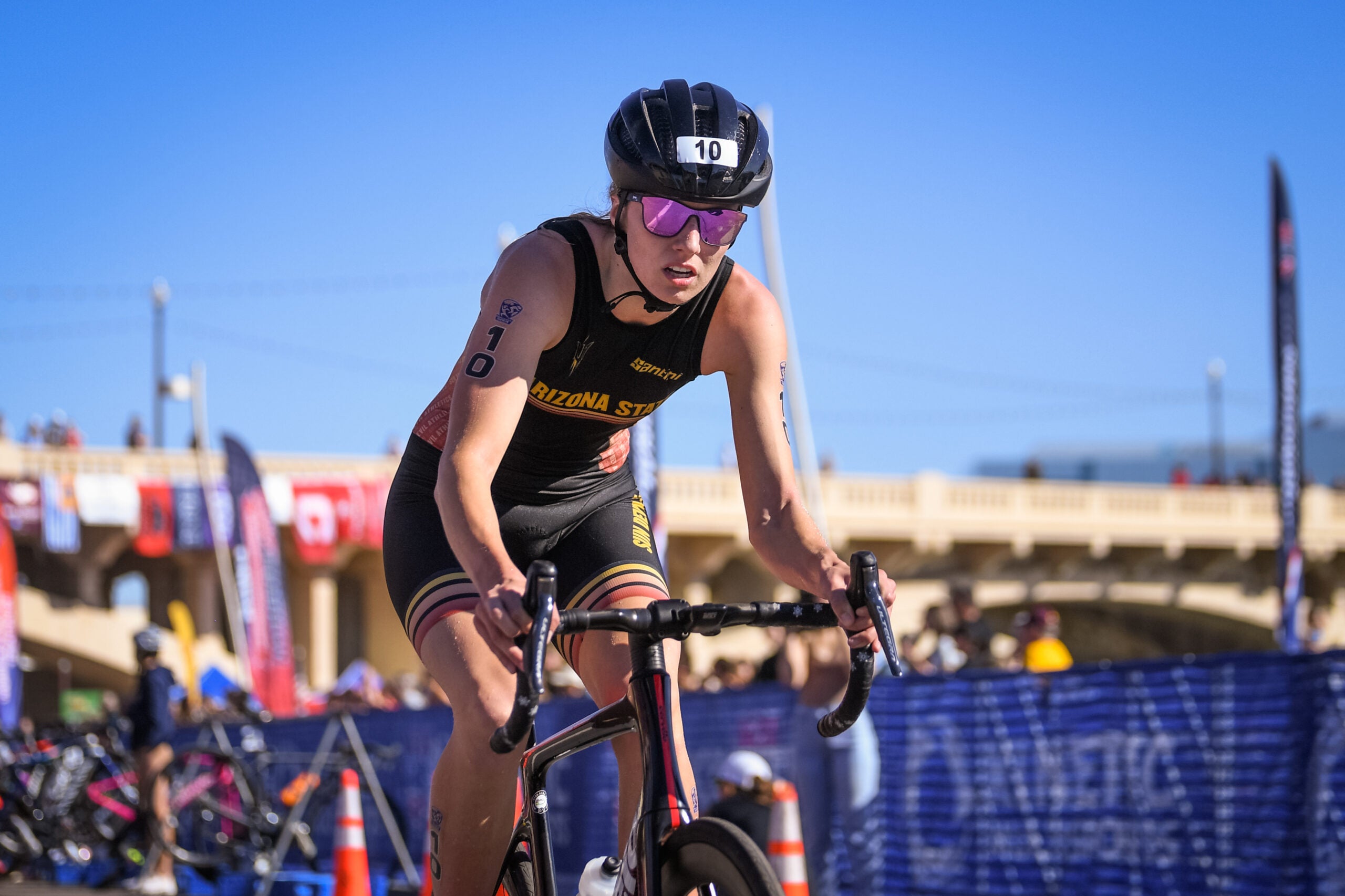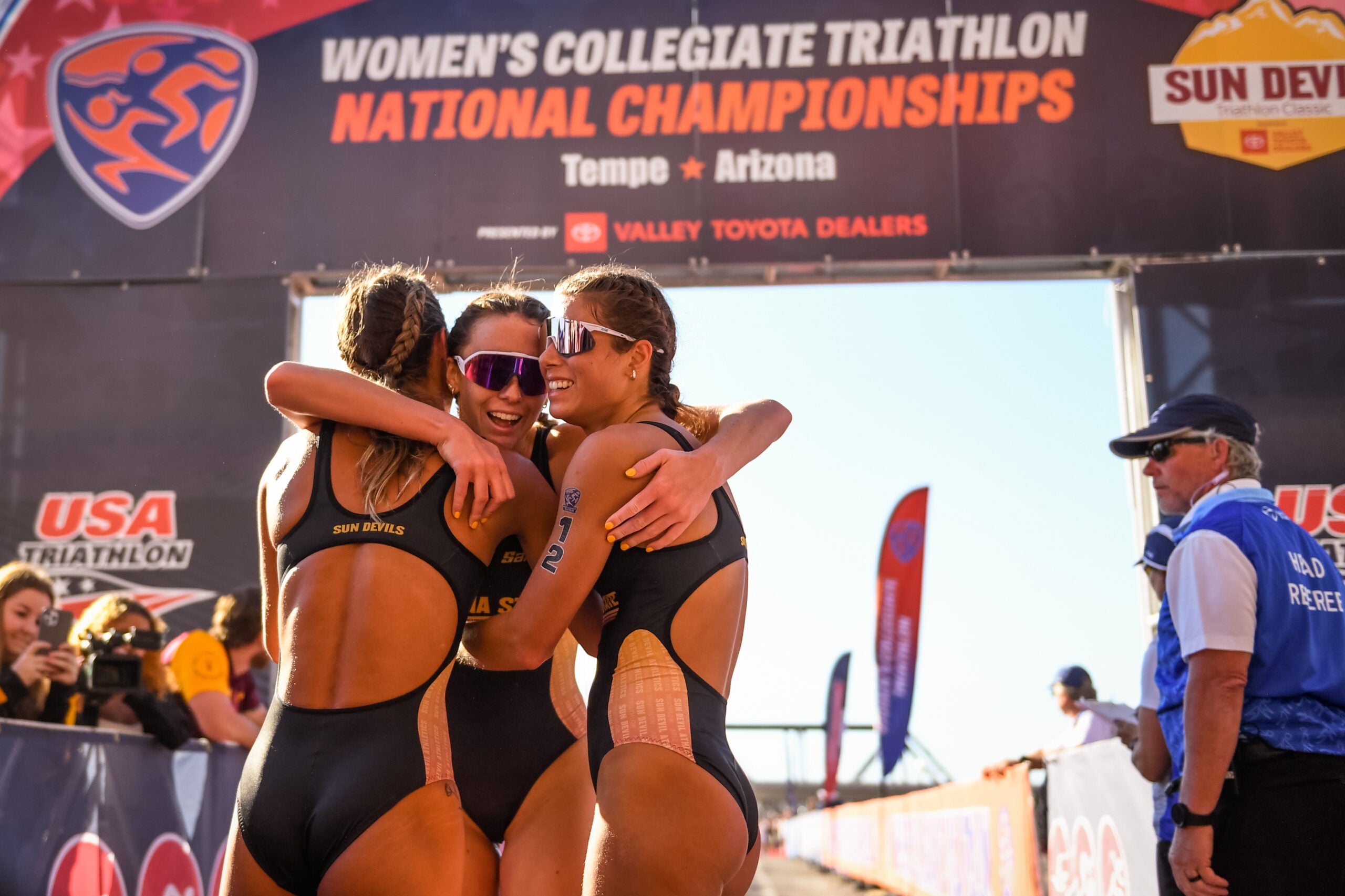What Makes Arizona State Women’s Triathlon So Damn Good?
There’s more than meets the eye when it comes to how the six-time national champion Sun Devils became the gold-standard NCAA triathlon team. (And we’ve got two of their key workouts.)
New perk! Get after it with local recommendations just for you. Discover nearby events, routes out your door, and hidden gems when you sign up for the Local Running Drop.
On Nov. 12, the Arizona State University women’s triathlon team collected its sixth straight varsity collegiate national title in Tempe, Arizona. ASU women took four of the top 10 spots in the NCAA Division I race, led by champion Amber Schlebusch and runner-up Liberty Ricca.
If that sounds like history repeating itself, you’re not wrong. The Sun Devils have dominated the NCAA women’s varsity triathlon landscape since 2016. Undefeated as a team at Nationals, ASU women have swept the podium twice, won four individual titles, and earned 12 individual podiums.
So, what’s the recipe for their secret sauce?
RELATED: Photos: ASU Makes it Six Straight at Women’s Collegiate Triathlon National Championships
Section dividerIf you build it, they will come
The NCAA approved triathlon as an Emerging Sport for Women in 2014. That effectively started the clock for USA Triathlon, giving the governing body 10 years to recruit 40 schools at the varsity level.
When Arizona State announced the addition of men’s ice hockey in fall 2014, the door opened to add a women’s sport. Nicole Welling, an elite triathlete and graduate student at the time, approached the athletic department with a proposal to add women’s triathlon. In October 2015, ASU became the first NCAA Power Five institution to add the sport.
Rocky Harris, USA Triathlon CEO from Aug. 2017-Aug. 2022, was an athletics administrator at ASU at the time. As a triathlete himself, he championed the addition of the sport alongside Athletic Director Ray Anderson and university president Michael Crow.
It also helps that as triathlon-friendly cities go, Tempe is near the top of the list. The city has welcomed high-profile races for decades — including Ironman Arizona, USA Triathlon National Championships, Life Time Tri Tempe, and ITU Pan American Cups — and has a thriving community of multisport clubs and group rides.
ASU brought Women’s Collegiate Nationals to Tempe in 2017, and has hosted the race every year since (the season was canceled in 2020).
“We felt it was an opportunity to showcase the sport to potential donors and future athletes who grew up in the valley, and really make ASU Triathlon in Tempe into what Omaha is for baseball, or what Oklahoma is for softball,” Harris said. “When you do that, it builds the culture and the level of support you’re trying to create.”

The right coach at the right time
Cliff English was hired as head coach for the inaugural program, bringing 15 years of elite coaching experience. Welling supported as operations coordinator, and later assistant coach.
English had led athletes to all the major Games (Olympic, Pan American, and Commonwealth), multiple world titles, and hundreds of professional podiums.
When he got the offer from ASU, he was impressed by the school’s commitment to Olympic sports. The Sun Devils had just hired Bob Bowman, Michael Phelps’ coach, to lead the swim program, and were also building Olympic-caliber talent in the wrestling, track and field, and golf programs.
“Ray (Anderson) always said that at ASU, we’re more than basketball, baseball, and football. So, I thought, ‘Okay, we can do something here,’” English said. “We’ve got the location. We’ve got the weather. We’ve got the facilities. I’ve got six-and-a-half scholarships. I’ve got a pretty decent budget. So, I hit the ground running, getting into the community, and letting people know what we were doing.”
With scholarships on offer at a Power Five school, English was able to recruit top U.S. and international talent almost immediately — including early stars Katie Gorczyca, the 2017 USA Triathlon U23 Athlete of the Year, and Charlotte Ahrens, the 2015 German junior national champion.
“They have the ‘it’ factor,” said Tim Yount, Chief Sport Development Officer at USA Triathlon, who leads the governing body’s NCAA programming. “The pride they have oozes when they race, and they always look the part of being one of the best in the U.S. These women know how to race at the highest levels.”
RELATED: Will NCAA Triathletes Cash in on NIL Deals?
Section dividerA culture of excellence — and balance
The ASU women are some of the best up-and-coming triathletes in the world, and many harbor Olympic dreams. But English is as committed to his athletes’ well-being as he is to their competitive success.
The balance pays off. Women’s triathlon consistently has the highest GPA of ASU’s 26 varsity sports.
“Happy and healthy makes a hungry athlete,” English said. “Stress is stress, whether it’s a training load or school. If you’ve got an exam and you’re up late, you don’t need to come to practice tomorrow. I’d rather you not get sick. You can be ambitious as a coach and want to win — but at the same time, you’re coaching young adults, so we try to be very mindful of that.”
Hannah Henry, a two-time individual national champion for ASU, is now in graduate school and volunteer coaching with English and Welling.
“It’s special to have been part of such a strong and consistent team of talented women for the past five years,” Henry said. “When I was on the team, I not only felt looked after as an athlete, but also cared about as a person. You see how hard your teammates work, so you want to see one another perform well.”
Schlebusch, who broke the tape at Nationals this year, said English supported her in stepping away from the sport over the summer. She went home to South Africa for the first time in two years and took care of her mental health, only to return refreshed and stronger than ever.
“Not once did Cliff make me feel like I was catching up or that I wasn’t the athlete I should be,” Schlebusch said. “He’s the one who told me to just be patient, the training will come, and the results will show. After that break, I came back, and I had this spark for training again.”
Outside of the mixed relay, collegiate triathlon is perhaps the last time these women will race their sport in a team environment — and that’s something to treasure.
“We work so hard at making it a safe space for each other, and that shows in the racing,” Schlebusch said. “When we cross the line and collapse into each other’s arms, that’s one of the most special feelings, because we’ve all gone through the same process. It’s quite beautiful to see how strong and mature we’ve grown as a team.”

ASU Signature Workouts
Train like a collegiate champion with these sessions that are key for the Arizona State University women’s triathlon team.
Workout 1
2 Weeks Out Bike-Run Brick
Warmup:
40min. with 1×5-minute effort up to FTP (Functional Threshold Power, or 85% effort)
Main set:
2x
(10min. bike with 3-4 training partners rotating in single paceline, shorter pulls of 30 seconds, with average power just at FTP
Fast dismount and T2
1 km run off the bike at 5k effort and a little above
6min. recovery easy run and spin, then start over)
Cooldown:
30min. spin
Workout 2
1 Week Out Swim-Bike Brick
Sharpen the swim-bike brick, with a goal of targeted neuromuscular work — simulating a hard swim finish, getting onto the bike and going 90%.
BikeWarmup:
10-15 min on trainer on pool deck
Swim Warmup:
400 swim choice warmup 15 seconds rest
4x 100 15 seconds rest as:
Odds – 25 drill /25 build/ 50 smooth aerobic
Evens – 100 low pull or pull + board aerobic
8x 25 as easy to fast, fast to easy, build, fast on :30
2x 100 aerobic and smooth 15 seconds rest
Pre-Set:
2x 200 negative split to 750 effort on 3:00
100 ez on 2:00
Main Set:
3x 300 @ 750 effort on 4:00
100 easy on 2:00
3x
(200 swim @ 750 effort w/last 50 picking up to swim exit speed — run to bike and then 2min. race simulation with hard efforts immediately — getting feet in shoes with full race re-enactment /visualization
4min. recovery of spin/swim)
Cooldown:
Choice
RELATED: Triathlon Hits Mark to Become Next NCAA Sport
